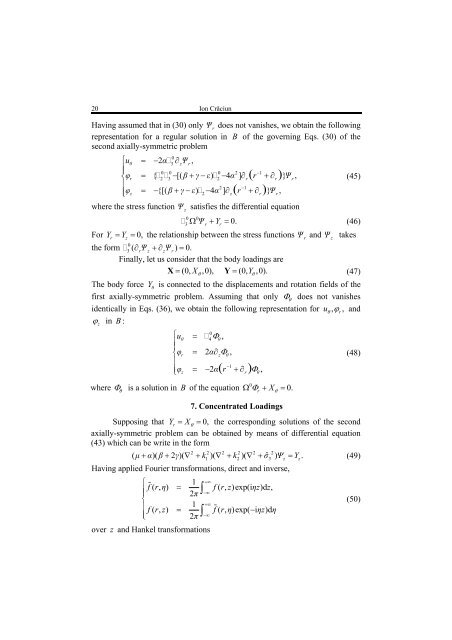BULETINUL INSTITUTULUI POLITEHNIC DIN IAŞI
buletinul institutului politehnic din iaşi - Universitatea Tehnică ...
buletinul institutului politehnic din iaşi - Universitatea Tehnică ...
- No tags were found...
You also want an ePaper? Increase the reach of your titles
YUMPU automatically turns print PDFs into web optimized ePapers that Google loves.
20 Ion Crăciun<br />
Ψ r<br />
Having assumed that in (30) only does not vanishes, we obtain the following<br />
representation for a regular solution in B of the governing Eqs. (30) of the<br />
second axially-symmetric problem<br />
0<br />
⎧ uθ = −2 α<br />
3<br />
∂zΨr,<br />
⎪<br />
0 0 0 2 −1<br />
⎨φr<br />
= {<br />
2 3− [( β+ γ−ε) 2−4 α ] ∂<br />
r( r +∂r)<br />
} Ψ<br />
r,<br />
⎪<br />
2 −1<br />
⎪⎩ φz<br />
= − {[( β+ γ−ε) 2<br />
−4 α ] ∂<br />
z( r +∂r)<br />
} Ψ<br />
r,<br />
where the stress function<br />
Ψ z<br />
satisfies the differential equation<br />
(45)<br />
0 0<br />
3<br />
Ω Ψ + Y = 0.<br />
(46)<br />
r<br />
r<br />
For Y = Y = 0, the relationship between the stress functions Ψ and Ψ takes<br />
r<br />
z<br />
0<br />
the form<br />
3<br />
( ∂<br />
rΨz +∂<br />
zΨr)<br />
= 0.<br />
Finally, let us consider that the body loadings are<br />
X= (0, X ,0), Y = (0, Y ,0).<br />
(47)<br />
The body force<br />
Y θ<br />
θ<br />
θ<br />
is connected to the displacements and rotation fields of the<br />
first axially-symmetric problem. Assuming that only Φ<br />
θ<br />
does not vanishes<br />
identically in Eqs. (36), we obtain the following representation for u θ<br />
, ϕ<br />
r<br />
, and<br />
ϕ<br />
z<br />
in B :<br />
⎧<br />
0<br />
uθ<br />
=<br />
4Φθ,<br />
⎪<br />
⎨φr = 2 α∂zΦθ<br />
,<br />
(48)<br />
⎪<br />
−1<br />
⎪⎩ φz = − 2 α( r +∂r)<br />
Φθ<br />
,<br />
where Φ<br />
θ<br />
is a solution in B of the equation<br />
0<br />
Ω + =<br />
Φ r<br />
X θ<br />
7. Concentrated Loadings<br />
Supposing that Yr<br />
= X θ<br />
= 0, the corresponding solutions of the second<br />
axially-symmetric problem can be obtained by means of differential equation<br />
(43) which can be write in the form<br />
( μ + α)( β+ 2 γ)( ∇ + k )( ∇ + k )( ∇ + σˆ<br />
) Ψ = Y .<br />
(49)<br />
2 2 2 2 2 2<br />
1 2 3<br />
Having applied Fourier transformations, direct and inverse,<br />
⎧<br />
1 +∞<br />
f%<br />
(, r η) = f(,)exp(i r z ηz)d,<br />
z<br />
⎪<br />
2π<br />
∫−∞<br />
⎨<br />
1 +∞<br />
⎪ f(,) r z = f%<br />
(, r η)exp(i − ηz)dη<br />
⎪⎩<br />
2π<br />
∫−∞<br />
over z and Hankel transformations<br />
z<br />
0.<br />
z<br />
r<br />
z<br />
(50)

















